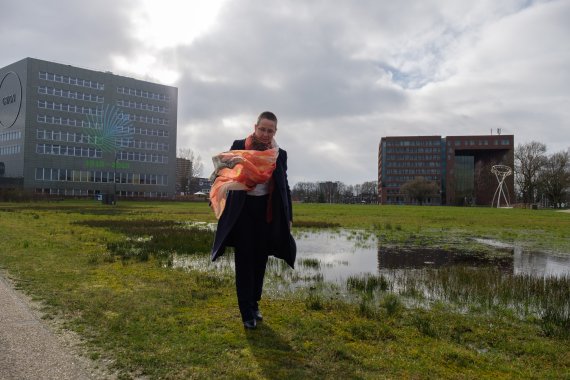Sanda Lenzholzer is the new chairholder at Landscape Architecture. She is the first woman professor in this subject area in the Netherlands. ‘That is extraordinary: there are a lot of women students, who often get the best grades too. But in the world of design bureaus in landscape architecture and urban planning, it is still mainly men who are in charge. We need a change of culture.’
Lenzholzer has been knocking around Wageningen for quite a while. After obtaining degrees in Germany and the UK, she worked in several design bureaus before deciding in 2004 to pursue an academic career.
Why go back to academia?
‘I was looking for more depth. In some design bureaus you mainly do project management. The actual designing, the creative process, only takes up 10 per cent of your time. There is no time for pondering, for critical reflection and depth. To be honest, I was starting to get a bit bored. It is not the same everywhere, though. At Mecanoo, I did a lot of design research and I find that very interesting. I wanted to go into that in greater depth.’
In Wageningen you developed into an expert on the urban microclimate? How did you come to focus on that theme?
‘During my time at design bureaus I designed a lot of public spaces. A design for a city square went wrong because nobody thought about the local wind situation. Once the design had already been implemented, I had to make adjustments that meant the whole design concept got lost. In practice, nobody gave any thought to microclimates at that time. So I thought: something’s wrong here. That was one of the triggers for me. And it was also clear to me that climate adaptation was going to become a major theme. And nobody in the Netherlands was doing anything on it back then.’
As a landscape architect I don’t need climate change to do something meaningful for this society
Is climate change a blessing for your profession?
‘A blessing because it creates urgency? No. There are so many themes other than climate change that landscape architects need to address. The energy transition, the circular economy, new autonomous mobility, demographic developments, etc. And it’s all interconnected. We’ve got so much on our plates that we must all do our research through integral design. As a landscape architect, I don’t need climate change to do something meaningful for this society.’
Research through design is the crux of your approach. What is that, actually?
‘It is a design process in which you alternate between designing and thoroughly researching the design. You create several options for a design and then test them. That helps you arrive at improvements and after a few such steps, you get an optimal outcome. The term has existed for some time, but here in Wageningen it’s about Research with a capital R, meaning scientific testing. I’ve shaped it within Landscape Architecture through my publications, together with colleagues.’
I’m not jumping to the conclusion that is all far too complex
What does that research consist of?
‘There are many ways of doing it: using computer simulation you can make reasonable predictions, you can consult focus groups of users or citizens, or you can get experts from the field to reflect. Within ESG (Environmental Sciences Group, ed.) we are now working on setting up a visualization lab, in which you can you can use virtual reality to move around a designed landscape or space and simulate all kinds of things, such as smell and temperature.’
How are you going to go about your professorship?
‘I am not going to focus exclusively on the urban climate, but on all public space in cities. All those issues I listed earlier are at work at the same time. If we tackle them all separately, there will be construction work going on in the cities for the next 20 years. And you don’t want that. So we need to find an integral approach and synergy. With the chair group and our colleagues in spatial planning, I also want to focus on the major transitions in rural areas, such as the energy transition and circular agriculture, because they call for major interventions too.’
Isn’t that extremely ambitious?‘
Yes, but you don’t have to work everything out to the last detail to know whether you are on the right track. You can get quite a long way using rules of thumb. You need to involve a lot of experts and sometimes you’ll discover conflicts between themes. But conflicts can often lead to innovation. I’m not jumping to the conclusion that it is all far too complex. I’m too much of a designer and an optimist for that.’
| The unfinished campus |
|---|
| The microclimate on the campus is not that great, according to Sanda Lenzholzer. It was planned in a period when no one gave any thought to microclimates. ‘There aren’t enough places that provide shelter. The campus is one big green sheet with colossal buildings on it, connected with paths.’ What the campus lacks, in Lenzholzer’s view, is avenues of trees and pleasant outdoor spaces. The campus’s aura could use a ‘boost’ too. ‘Most of the buildings are large hermetic forts dotted around a windy, bare, flat field. And that field is our ‘events location for the AID. That’s not a good idea! An event location should be on the edge of a town: here it’s right in the middle. Actually what should stand here is an inviting building, which suggests what we are doing here at WUR, and that we are creative. It could be the location for the visualization lab, design studios, fablabs and an exhibition hall, for example. That would give the campus a strong appeal.’ |

 Sanda Lenzholzer. Photo: Guy Ackermans
Sanda Lenzholzer. Photo: Guy Ackermans